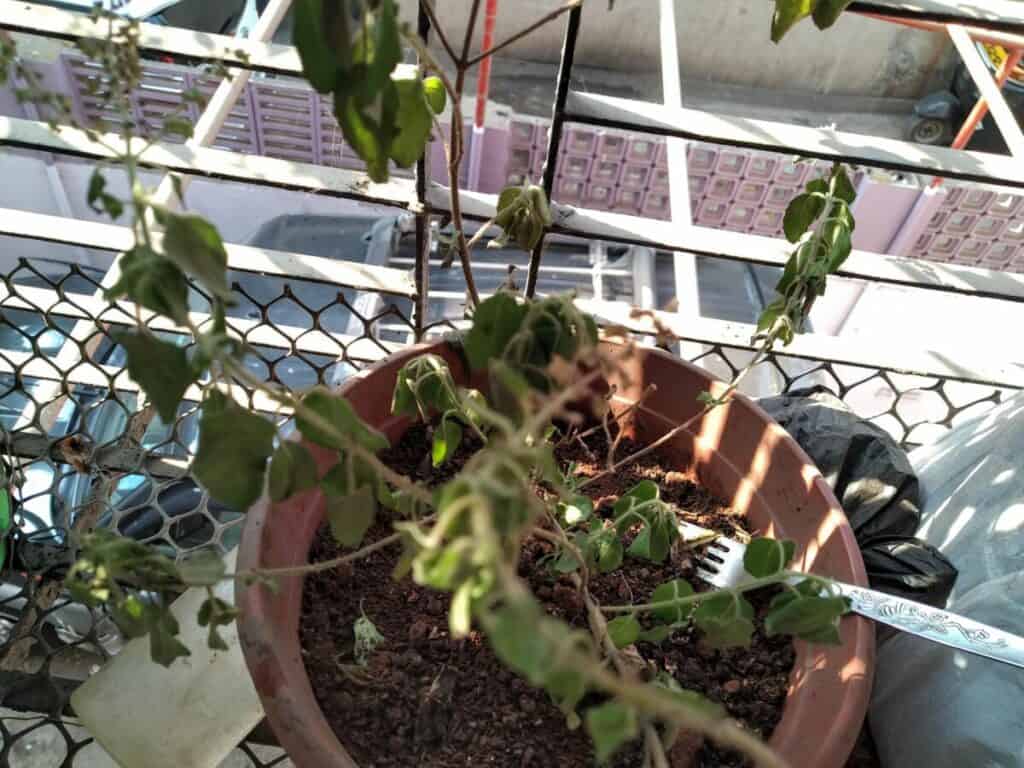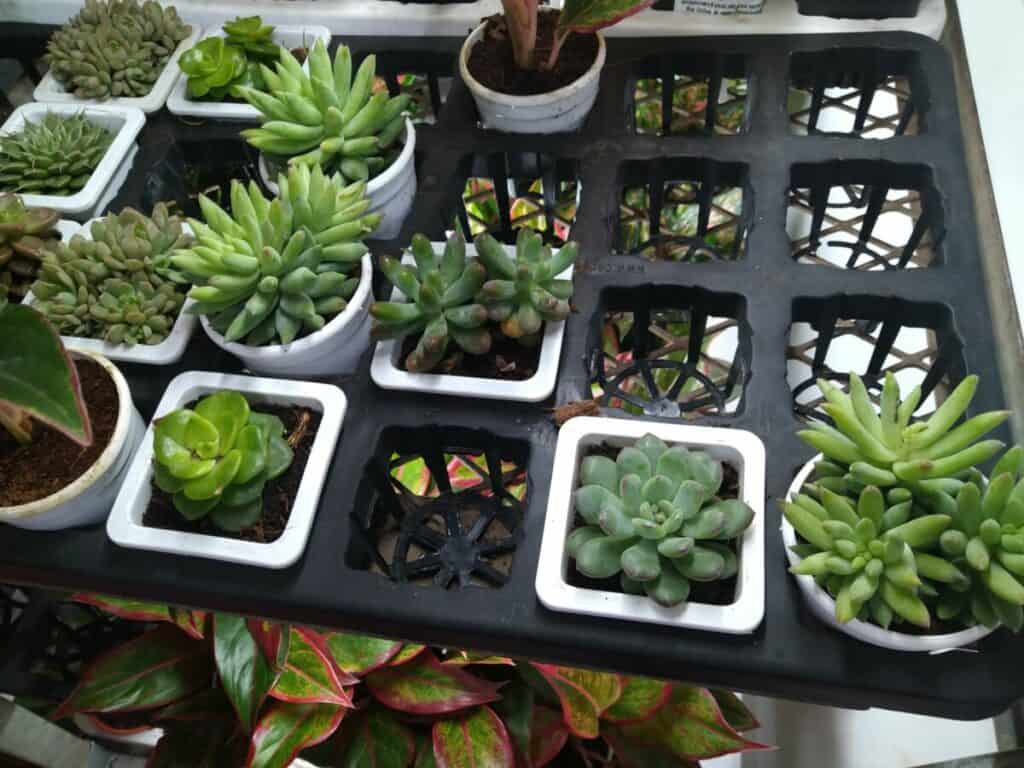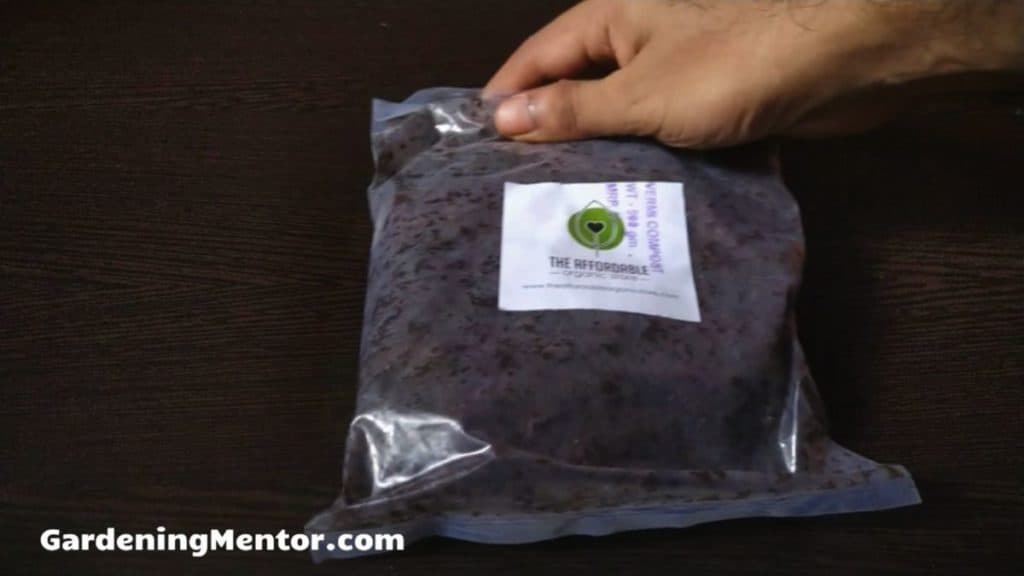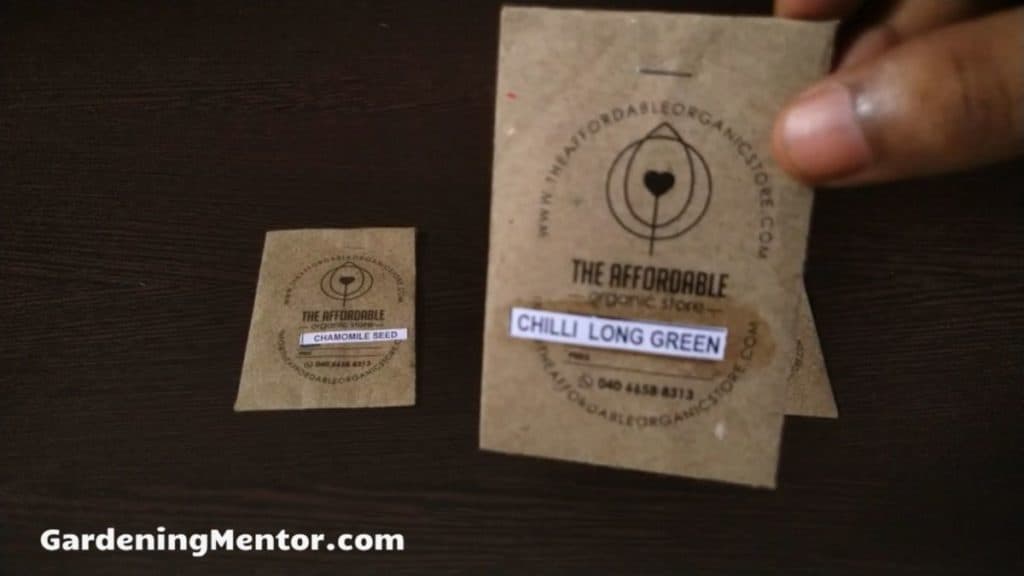It’s exciting to watch your seedlings germinate, but it can be frustrating if their growth is very slow. You feel like pulling out your hair on what is the reason for this problem.
Your seedlings are growing slow because they are facing transplant shock as you transplanted them. Your seedlings may grow slow because of too little nutrients available to them. They may grow slow due to lack of water or providing excess water.
Let’s take a look at these issues so you can figure out which one is affecting your seedlings and what you can do about it.
1. Transplant shock
You may have germinated seeds in seed-starting trays indoors. And now they have grown into seedlings. Or you may have bought the seedlings from a garden center or nursery.
It’s time to transplant the seedlings outdoors in your garden. But if you don’t take care during the transplant, the seedlings will suffer from transplant shock.
The change in the temperature, light, wind, and humidity can stress the seedlings and they won’t grow well. If the seedlings are unable to adapt to the new environment, they may even die.
The solution to this problem is to harden the seedlings before you transplant them outdoors. Hardening is a process where you help the seedlings gradually adapt to the environment.
You can do this by keeping the seedlings outdoors every day for a few hours. Make sure to keep them away from direct sunlight, rain, and wind.
Keep doing this for a week and the seedlings will be ready for transplant outdoors without any problems.
2. Lack of sunlight
The amount of sunlight your seedlings will need depends on the type of plant. Some plants are shade-loving and can survive with little sunlight.
But many plants especially edible ones need full sunlight. This means at least 6-8 hours of sunlight every day to grow well.
If you plant the seedlings in a location that is not getting enough sunlight, they will turn leggy as they stretch to try to get more light. The seedlings can’t produce the food that they need and their growth will be slow.
The solution is to plant the seedlings in the location of your garden that gets the required amount of sunlight. Make sure to plant them before the taller plants so they don’t get shade. Make sure they are not covered by a wall or fence that will block the sunlight.

If you’ve already planted the seedling and are facing this problem, you’ll either need to remove the obstructions if possible. If not, you’ll need to move the seedlings to another location in the garden that can provide them the sunlight they need.
If the seedlings are for plants that need shade, you need to protect them from too much sunlight. This will cause them stress and they won’t grow well. So for these plants, you actually need to put a layer of shade in place.
You can grow them near tall plants, trees, or walls that can provide the necessary shade. Or you can use a cover to shade them from the sunlight.
3. Overwatering or underwatering
One of the basic mistakes most beginner gardeners make is to overwater or underwater the seedlings. Both of these will cause a lack of nutrients in the plant and cause their growth to slow down.
It’s easy to see how underwatering can cause this problem. Too little water means the plant won’t be able to circulate the nutrients from the roots to the foliage. And this will slow down its growth.
The solution to underwatering is to keep a check on the moisture in the soil. If it’s dry, you can water it thoroughly so the moisture goes deep into the soil.
Stick your finger 1-2 inches in the soil and check whether the soil sticks to it. If your finger is clean, it means the soil is dry and needs good watering.

Overwatering can cause a lack of nutrients and we’ll see why. It’s a more serious issue than underwatering that can even kill the plant.
When you overwater the seedlings, it causes the roots to drown in water. This condition causes fungal issues like root rot or damping.
Root rot means the roots start decaying and reduce in number. So there is a lack of nutrients reaching the plant. Damping is a problem where the stem starts rotting and the circulation of nutrients is cut off.
Overwatering can occur because the drainage in the soil is not good enough. So make sure the soil has a good texture that retains moisture but drains out the excess.
If you’re growing the seedlings in a container, make sure there are drainage holes at the bottom to allow the excess moisture to flow out.
If the root rot has affected the seedlings, you’ll need to take them out and check them. If all the roots have turned brown and soggy, there’s not much you can do except dispose of the plant.
If there are still some light-colored healthy roots, you can then cut off the rotten ones and replant the seedling in another dry location.
4. Lack of heat
The plants that you want to grow will be warm-season or cool-season. The warm-season ones will need temperatures higher than 65 degrees to grow well. The cool-season ones will do well with temperatures around 50 degrees.
If the seedlings don’t get the required heat, they will not be able to grow well. They will spend time trying to survive the stress rather than growing foliage.
I would recommend planting the warm-season seedlings only when the last frost date in your area has passed. Wait for about 2-3 weeks after this average last frost date. This will be in the spring/summer season of your area.
And for the cool-season seedlings make sure to plant then when the summer temperatures have dropped and fall weather is arriving.
If you have a short growing season in your area, you may have to grow the seedlings indoors till the outside temperature is suitable for them. You can grow your seedlings with heating mats and grow lights till then.
Too much heat can also be a problem for the seedlings depending on what you are growing. Some of them will start to wilt due to the intense heat. While others will start to bolt and you won’t get the required foliage as the plant will start to die.
5. Poor soil conditions
You may have an in-ground garden, a raised bed, or a container garden. In any case, you need to have good soil suitable for the seedlings you are growing.
The soil contains sand, clay, and organic materials in varying amounts that give the soil its texture and quality. If the soil contains too much sand, it will drain moisture fast. If the soil contains a lot of clay, it will hold water longer and there is a risk of drowning the roots.
The type of soil depends on the plants you want to grow. Hardy plants like succulents would grow well in sandy soil. But edible plants need soil with a texture that retains enough water while draining out the excess.

If the seedlings don’t get the required soil type, they will grow slowly because the soil is too dry or too wet. And it may not have the right pH level in the soil.
You can avoid this problem by making sure to know the type of seedlings you’re growing and their soil requirements.
Make sure to use the right soil in your garden even if you have to spend a little more money and effort into this. I like to keep adding organic compost to the garden soil because it keeps improving the soil quality over time.

When you’re starting an in-ground garden, you can conduct a soil test by sending soil samples to your local extension service for a small fee. They will give you details about your soil and how you can amend it to make it suitable for the plants you want to grow.
If you’re building a raised bed, make sure to mix in a few inches of compost with the soil. And if you’re growing in containers, use good potting soil that is airy, light, and free from any sand or clay.
6. Lack of nutrients
Plants like us humans need nutrients to grow well. If your seedlings are not getting the required amount, they will not grow well.
When you start seeds, the nutrients are present in the seed itself and you don’t need to provide any excess. But once the seedling starts growing, it will need nutrients.
The amount of nutrients the seedling will need depends on the plant. Some plants like lavender can do with few nutrients and if you try to add more their growth will be poor.
But other plants like tomatoes are heavy feeders and need a lot of nutrients when growing foliage and fruit.
I prefer to use organic compost in the garden or potting soil as it provides the required nutrients to the plant. But you may not have access to compost or need more nutrients.
You will need to add fertilizer to the soil in such situations. I recommend using organic fertilizer as they are gentle on the seedling as well as the wildlife.

You can use a slow-release pellet fertilizer or liquid fertilizer for the seedlings. A slow-release fertilizer releases nutrients in the soil when you water it. It’s good to mix in this fertilizer when preparing the garden soil. And once every month when the plant is growing.
Liquid fertilizer is fast-acting and you can spray in on the soil and foliage after diluting it with water. It’s best to spray the liquid fertilizer every couple of weeks when the plant is growing. You can dilute it even further and spray it when watering the seedlings.
7. Lack of space
Different types of plants have different space requirements depending on their width when they are growing and fully mature.
You must check the seed packets of the seedling tags to understand how far you should space the seeds or seedlings from each other.

This is a common problem when growing plants in containers because you want to grow several plants in one and end up growing too many.
If the plants are too close to each other, the most common problem they will face is a competition for resources.
When you water the plant or add nutrients to the soil, each seedling will try to get those causing a lack of such resources. This will cause the growth of the seedlings to be stunted.
Another problem that happens when you grow plants too close to each other is they will not get enough sunlight. The foliage will block the light from reaching other foliage causing poor growth.
Growing plants close to each other causes reduction in the airflow and creates a humid condition. This is a common reason why plants get infected by fungal diseases.
The best solution is to plant the seedlings far from each other based on the specifications mentioned on the seed packet.
If you’re already growing seedlings too close, you can pull some of them out to create more space. And plant such seedlings in another location of your garden.
You may be able to get away by pruning some parts of the foliage to reduce the nutrient requirements of the plant. And it will improve the air circulation among the foliage as well. But your plant size will always be less than their full potential growth.
8. Slow growing plants
There are tons of plants you can grow in your garden. And each of these plants can have different variations with different genetics.
You may grow the seedlings for the same type of plant but because they have different genetics, one plant may grow faster than the other.
This does not mean anything is wrong with the other plant but it’s supposed to grow slow.
You must understand the seeds and seedlings you are using in your garden. You’ll find information on the seed packets or the tags on the seedlings when you purchase them.
If you prefer faster-growing plants, then choose a variety that will give you such results.
9. Pests
If you’re growing plants, at some point they will have pest problems. It’s not a big issue if the pests are limited in numbers as that’s part of nature.
The problem happens if the population of the pests goes out of control and they start eating up a lot of the seedling.
This will cause the seedling to come under stress. The pests may eat up the foliage, suck the sap out of them, or destroy the roots. This will cause a lack of nutrients in the seedling and stunt its growth.
The best way to deal with pests is with active pest management. I recommend checking on your seedlings every day in the morning when watering the plants.
If you see signs of insects on the foliage, you need to start thinking about actions to take. If the infestation starts to increase, you may be able to pull some insects by hand and dispose of them.
If that method is not feasible or does not work, you may have to use some insecticide to get rid of them. I would suggest using neem oil, horticultural oil, or vinegar to try to solve this problem. These will not harm your plant as some insecticides would.
For some pests, you may be able to grow companion plants in the garden that will repel them.
If the pests are animals like rabbits, moles, squirrels, or deer, you may need to use deterrents to scare them off. You could use a motion-activated sprinkler, a scarecrow, repellent plants, or chemicals.
10. Diseases
Your plants will get infected with a disease at some point and that is a part of gardening. Some diseases you may be able to get rid of while others will destroy the plant.
Some diseases may be cosmetic and make your seedlings look ugly but they won’t stunt their growth. But some other diseases will cause stress to the plant and they won’t grow well.
Your seedlings may be infected by fungal, bacterial, or viral diseases. Fungal diseases occur when there is a humid condition around your plant. Bacterial and viral diseases can reach your plant from wind, water, pests, or the soil itself.
To prevent fungal diseases, make sure to keep your garden clean and the plants well spaced. Water the plants at the base and don’t splash water on the foliage. It’s best to water in the morning so the excess water on the foliage will dry out as the sun comes out.
If your seedlings are infected by a fungal disease, you can try using neem oil or horticultural oil to get rid of it. This may work for some fungal diseases but not for all.

The other option is to cut off the part of the plant that is infected by the fungal disease. Sometimes, this may mean getting rid of the entire plant if the infected has spread a lot.
To prevent bacterial and viral diseases, keep pests out of your plants. Make sure to clean your garden tools with rubbing alcohol before using them on the plants.
You can try getting seeds and seedlings that are resistant to some bacterial and viral diseases.
Once the seedling has been infected by a bacterial or viral disease, you should cut off the infected portion of the plant. There is no treatment for many such diseases and you just need to live with them till the plant is fully infected and dies.

Fact Checked, Written, and Published by Kevin Rodrigues
Kevin is the founder of Gardening Mentor, a website that aims to teach people to grow their own food in a limited space. As a self-taught gardener, Kevin has spent several years growing plants and creating gardening content on the website. He is certified in Home Horticulture and Organic Gardening from Oregon State University. He has a Post Graduate Diploma in Horticulture and Landscape Gardening from Mumbai University.
Read more
